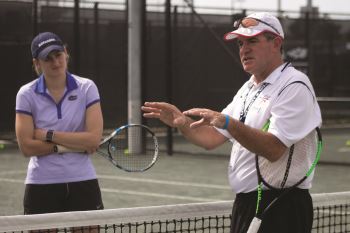Sid Newcomb, USPTA National Head Tester
 I spent 20 years at the same beautiful private club in Northern California. The first year at the club, I was the head tennis professional. During my second year, the tennis director left his position and I was fortunate to get a shot at the job. Something must have gone well for me to spend the bulk of my career in one place. However, I became a better tennis director with time due to a combination of experience on the job, being humbled by life’s hard knocks, my wife kicking my butt and proactively seeking continuing education to grow my skills as a tennis professional. If I could go back and tell a young me what to do right off the bat, here is what I would say.
I spent 20 years at the same beautiful private club in Northern California. The first year at the club, I was the head tennis professional. During my second year, the tennis director left his position and I was fortunate to get a shot at the job. Something must have gone well for me to spend the bulk of my career in one place. However, I became a better tennis director with time due to a combination of experience on the job, being humbled by life’s hard knocks, my wife kicking my butt and proactively seeking continuing education to grow my skills as a tennis professional. If I could go back and tell a young me what to do right off the bat, here is what I would say.
1. Say “yes” to at least one thing a year that doesn’t necessarily pay at the time.
When I was a young pro my focus was narrow. I had enough on my plate just taking care of the club members, my family was growing and my budget was tight…I was grinding. Everything seemed to depend on how much time I was on-court, that’s what paid. I ignored many opportunities to get involved with the USPTA and the USTA on a larger scale. I just didn’t have the time to give to something that didn’t pay money. Getting involved and volunteering for events in any capacity is connecting and networking with decision makers, and that pays off down the road. Now I would tell my younger self to budget one day a month or six times a year — anything to get involved in the sport outside of my immediate job at the club.
2. Write out lesson plans and goals for your regular students.
I had loads of students that I gave weekly lessons to for months and months. Now, I would write out process-oriented goals and share them with the students and with their parents if they are junior players. For example, for a 10-year-old student who plays regularly and wants to ramp up their competition starting in the upcoming summer, my lesson plan would look like this: “In the next three months, our goal is that you will be able to execute both first and second serves with a continental grip and a solid serve motion. To do this, we have to do x,y and z in our lessons and you have to do x,y and z in your daily practices.”
3. Attend a local, division, or national conference yearly.
You only know how much you don’t know or how much more you could know if you expose yourself to educational opportunities. Nothing is better than face to face, peer to peer learning. I would have loved to make an effort to get a clause written in my contract that the club or facility pays for some percentage of my yearly continuing education.
4. Play tennis for fun weekly.
The younger me wanted no part of being on a tennis court when I wasn’t working. I lost the fun of playing. I would say, no matter how busy, leave your club with a friend (not a member), go to some court other than where you work and hit for an hour or play some points. Don’t lose the love of the game that brought you to the job you are in the first place.
5. Run a completely new and different event every year.
Its remarkable to me how my club’s calendar looked so similar year in and year out. If we ran a successful event, then everyone wanted to do it again. There are so many ideas for different types of events, even if something went well the previous time, there is nothing wrong with changing it up and doing a different event. It’s said that “variety is the spice of life.” This keeps a freshness about the program both for you and your clientele.
About Sid Newcomb
Sid Newcomb is the National Tester for the USPTA. Before joining USPTA’s national staff, Newcomb was the director of tennis at Peninsula Community Center (PCC) in Redwood City, California since 1996. After a successful college career and a short stint in the minor leagues of tennis, he joined the coaching ranks at the Nick Bollettieri Tennis Academy where he was the European academy director for seven years.